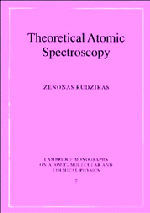Book contents
- Frontmatter
- Contents
- Preface
- Foreword to the Paperback Edition
- Introduction
- Part 1 Energy Spectrum of Many-electron Atom. Radiative and Autoionizing Transitions (Initial Formulas)
- Part 2 Foundations of the Angular Momentum Theory. Graphical Methods
- Part 3 Description of Complex Electronic Configurations
- Part 4 Second-quantization in the Theory of an Atom. Quasispin and Isospin
- Part 5 Matrix Elements of the Energy Operator
- Part 6 Electric and Magnetic Multipole Transitions
- Part 7 Calculation of Energy Spectra and Electronic Transitions in the Case of Complex Configurations
- 28 Methods of determination of radial orbitals
- 29 Correlation effects. Perturbation theory
- 30 The role of gauge dependence, relativistic and correlation effects in electronic transitions
- 31 Peculiarities of the structure and spectra of highly ionized atoms
- 32 Global methods in the theory of many-electron atoms
- 33 Peculiarities of configurations with vacancies in inner shells
- Epilogue
- References
- Index
31 - Peculiarities of the structure and spectra of highly ionized atoms
Published online by Cambridge University Press: 21 September 2009
- Frontmatter
- Contents
- Preface
- Foreword to the Paperback Edition
- Introduction
- Part 1 Energy Spectrum of Many-electron Atom. Radiative and Autoionizing Transitions (Initial Formulas)
- Part 2 Foundations of the Angular Momentum Theory. Graphical Methods
- Part 3 Description of Complex Electronic Configurations
- Part 4 Second-quantization in the Theory of an Atom. Quasispin and Isospin
- Part 5 Matrix Elements of the Energy Operator
- Part 6 Electric and Magnetic Multipole Transitions
- Part 7 Calculation of Energy Spectra and Electronic Transitions in the Case of Complex Configurations
- 28 Methods of determination of radial orbitals
- 29 Correlation effects. Perturbation theory
- 30 The role of gauge dependence, relativistic and correlation effects in electronic transitions
- 31 Peculiarities of the structure and spectra of highly ionized atoms
- 32 Global methods in the theory of many-electron atoms
- 33 Peculiarities of configurations with vacancies in inner shells
- Epilogue
- References
- Index
Summary
Peculiarities of multiply charged ions
Extensive studies of energy spectra and other characteristics of atoms and ions allow one to reveal general regularities in their structure and properties. For example, by considering the lowest electronic configurations of neutral atoms, we can explain not only the structure of the Periodical Table of elements, but also the anomalies. The behaviour of the ionization energy of the outer electrons of an atom illustrates a shell structure of electronic configurations.
Multiply charged ions represent a peculiar world, essentially differing from the world of neutral atoms or their first ions. In this chapter we shall try to describe these peculiarities. Main attention will be paid to the need for a combination of theoretical and experimental studies of the spectra of highly ionized atoms, and to the role of relativistic and correlation effects for multiply charged ions, and to the regularities and irregularities of the behaviour of their spectral characteristics along isoelectronic sequences.
Recently intense beams of ultracold highly ionized atoms up to naked uranium (U92+) have been obtained. Single ions were confined in ion traps, ion crystals were observed, and the phase transition from ion cloud to crystal was noticed. With increase of ionization degree the radiation of the ions moves to a shorter and shorter wavelength region, thus requiring special measurement techniques. For very highly ionized atoms (e.g. hydrogen-like bismuth), transitions between the hyperfine structure components occur in the optical region. It is very useful, to know the wavelength domain of the radiation of such ions. The relevant calculations here are very helpful.
- Type
- Chapter
- Information
- Theoretical Atomic Spectroscopy , pp. 368 - 379Publisher: Cambridge University PressPrint publication year: 1997



